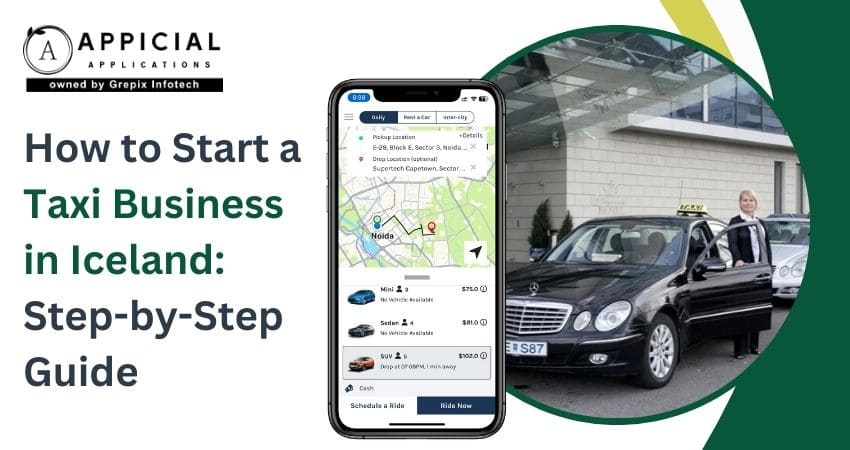
How to Start a Taxi Business in Iceland: Step-by-Step Guide
Have you ever dreamed of starting a taxi business in Iceland? With its breathtaking landscapes, booming tourism industry, and growing demand for reliable transportation, Iceland is an ideal place to launch a successful taxi operation. Visitors from all over the world flock to Iceland for its famous glaciers, volcanoes, and the Northern Lights, and most rely on taxis to get around.
Starting a taxi business in Iceland offers a lucrative opportunity, but it’s not as simple as putting a cab on the road. From understanding local regulations to adapting to Iceland's unpredictable weather conditions, there are unique challenges and rewards. This step-by-step guide will walk you through everything you need to know, ensuring your venture has a smooth ride.
Starting a taxi business in Iceland offers a lucrative opportunity due to the country’s thriving tourism industry and growing need for reliable transportation. Visitors flock to Iceland year-round to experience its stunning landscapes, from glaciers to the Northern Lights, creating consistent demand for taxi services. However, success requires careful planning, from understanding local regulations and conducting market research to building a suitable fleet and meeting legal requirements. Partnering with a leading taxi app development company like Appicial Applications can simplify the process. Appicial’s cutting-edge technology ensures seamless booking, efficient operations, and outstanding customer service, giving your taxi business a competitive edge.
How to Start a Taxi Business in Malta: Step-by-Step
1 Understanding the Taxi Industry in Iceland
Market Overview
Iceland's tourism industry has grown exponentially over the last decade, welcoming millions of visitors annually. With such growth comes a rising demand for transportation services, especially in cities like Reykjavik and popular tourist spots such as the Blue Lagoon and Golden Circle. Not only tourists but also locals require reliable transport for daily commutes or emergencies during winter.
Despite the high demand, the taxi market in Iceland isn’t overly saturated, offering room for new businesses to thrive. However, competition can still be stiff, especially from ride-sharing apps and established taxi companies. Understanding the current market trends and pinpointing opportunities will set you up for success.
Identifying Your Niche
When starting your taxi business, identifying a niche can help you stand out. Are you planning to cater to tourists, locals, or both? For instance, offering specialized services for travelers, such as guided tours, airport transfers, or even luxury rides, can attract more customers. Alternatively, you can focus on affordable, standard rides to cater to residents.
Think about how your services can address customer needs. For example, in Iceland’s harsh winters, having vehicles equipped with heated seats and snow tires can be a unique selling point. Finding your niche will determine your branding and service approach.
2 Research and Planning for Your Taxi Business
Conducting Market Research
Before jumping into the taxi business, thorough market research is crucial. Start by identifying your target audience: who are they, where do they live, and what do they expect from a taxi service? Speak to locals, tourists, and even current taxi operators to gain insights.
Analyze your competition by studying existing taxi companies and their service offerings. Look for gaps you can fill—whether it’s offering eco-friendly vehicles, 24/7 availability, or personalized travel experiences. Understanding customer preferences will help you tailor your services to stand out.
Creating a Business Plan
Once you’ve gathered your research, it’s time to create a detailed business plan. This document will serve as your roadmap, outlining your goals, operational strategy, and financial plan. Here’s what to include:
- Business Goals: Define short-term and long-term objectives.
- Budget Planning: Estimate your startup costs, including vehicle purchases, insurance, licenses, and marketing expenses.
- Revenue Projections: Calculate potential earnings based on your pricing strategy and expected demand.
A solid business plan not only helps you stay focused but is also essential if you’re seeking loans or investors.
3 Meeting Legal Requirements in Iceland
Obtaining Licenses and Permits
In Iceland, starting a taxi business involves meeting several legal requirements. The first step is obtaining a taxi operating license from the Icelandic Transport Authority. This license ensures you comply with local regulations and safety standards. You’ll also need to ensure that your drivers have valid taxi driver certifications.
Additionally, Iceland has strict environmental regulations, so ensure your vehicles meet emission standards. For those planning to cater to tourists, having guides licensed by the Icelandic Tourist Board can be a bonus.
Registering Your Business
To operate legally, register your business with Iceland’s tax authorities. Decide on the type of business entity—whether it’s a sole proprietorship, partnership, or limited liability company. Each has pros and cons, so consult a legal expert if needed.
Ensure you understand Iceland’s tax system, as you’ll need to collect and pay Value Added Tax (VAT) on your services. Proper registration not only keeps you compliant but also builds trust with customers.
4 Building Your Fleet
Choosing the Right Vehicles
Your fleet is the backbone of your taxi business, so selecting the right vehicles is critical. Consider Iceland’s unique conditions—vehicles need to handle icy roads, snow, and sometimes even off-road conditions. Fuel-efficient and environmentally friendly cars are also a plus, as Icelanders prioritize sustainability.
Focus on comfort, safety, and durability when choosing your vehicles. Features like heated seats, ample trunk space, and GPS navigation systems will enhance the customer experience.
Purchasing or Leasing Vehicles
Next, decide whether to buy or lease your vehicles. Buying allows you to build equity in your fleet but requires significant upfront investment. Leasing, on the other hand, offers lower initial costs but can lead to higher long-term expenses.
Evaluate your budget and financial goals to determine the best option for your business. Whatever route you choose, ensure your vehicles are insured and comply with Icelandic regulations.
5 Hiring Drivers
Qualifications and Skills
Hiring qualified drivers is one of the most critical steps in running a taxi business. In Iceland, drivers must hold a valid Icelandic driver’s license, and in some cases, specific training or certification may be required to operate taxis. Depending on the service you offer, drivers may also need additional skills, such as fluency in multiple languages to assist tourists or in-depth knowledge of Iceland's popular landmarks.
Additionally, focus on hiring drivers who possess excellent customer service skills. A friendly, professional attitude can significantly enhance customer experience and lead to repeat business. Ensure your drivers understand Iceland’s challenging road conditions, especially during winter when icy roads and blizzards are common.
Training Programs
Once you’ve hired drivers, invest in training programs to ensure they are well-prepared. These should include:
- Navigation Training: Teach drivers to use GPS systems and understand routes to Iceland’s top attractions and remote locations.
- Customer Service: Train drivers on how to communicate effectively with passengers and handle complaints professionally.
- Safety Training: Cover vehicle safety protocols, winter driving techniques, and emergency response.
A well-trained team of drivers will reflect positively on your business, enhancing its reputation and ensuring customer satisfaction.
6 Developing a Pricing Strategy
Setting Competitive Rates
Pricing is a key factor in attracting customers and staying competitive. Research the average rates in Iceland for similar taxi services, considering base fares, per-kilometer charges, and waiting time fees. You’ll need to strike a balance between affordability and profitability while factoring in operating costs like fuel, maintenance, and salaries.
Offering transparent pricing can also build trust with customers. Use a fare calculator or display rate charts on your website or app to avoid misunderstandings.
Offering Unique Packages
To stand out, consider offering tailored packages for tourists and locals. For example:
- Tour Packages: Offer guided rides to popular destinations like the Golden Circle, Jökulsárlón Glacier Lagoon, or the Blue Lagoon.
- Airport Transfers: Provide flat-rate services for airport pickups and drop-offs.
- Hourly Rentals: Allow customers to book taxis for a set duration to explore the island comfortably.
These options not only cater to diverse customer needs but also increase your revenue potential.
Also Read: Best Taxi App in Iceland: A Pioneering Ride-Hailing Experience
7 Leveraging Technology
Setting Up a Booking System
A seamless booking experience is crucial in today’s tech-driven world. Invest in a user-friendly app or website where customers can book rides, view rates, and track drivers in real-time. Features like multiple payment options (e.g., credit cards, mobile payment apps) and multi-language support will enhance accessibility for tourists.
Adding GPS tracking to your vehicles not only helps customers monitor their rides but also ensures driver accountability and safety.
Marketing Your Business Online
Online marketing is essential to reach your audience in Iceland and abroad. Start by creating a professional website that highlights your services, rates, and contact information. Use social media platforms like Facebook and Instagram to share engaging content, such as scenic rides, customer reviews, or limited-time promotions.
Partnering with local hotels, travel agencies, and tour operators can boost your visibility. By working together, you can create mutually beneficial referral systems.
8 Managing Your Business Operations
Tracking Expenses and Revenue
Effective financial management ensures your taxi business remains profitable. Use accounting software to track expenses, revenue, and profit margins. Categorize costs such as vehicle maintenance, fuel, driver salaries, and marketing to identify areas where you can save.
Regularly review your financial performance to spot trends and adjust your pricing strategy or expenses.
Ensuring Vehicle Maintenance
Your vehicles are the heart of your business, so keeping them in top condition is non-negotiable. Schedule regular maintenance checks for tire replacements, oil changes, and brake inspections. Investing in preventive maintenance helps avoid costly breakdowns and ensures passenger safety.
9 Scaling Your Taxi Business in Iceland
Expanding Your Fleet
Once your business is established, consider investing in additional vehicles to accommodate growing demand. Adding eco-friendly options like hybrid or electric cars can also appeal to environmentally conscious customers.
Partnering with Local Businesses
Collaborating with Iceland’s travel industry can unlock new opportunities. Partner with hotels, tour companies, and local attractions to offer bundled packages or exclusive discounts. These partnerships can drive more customers to your business while boosting your brand visibility.
Conclusion
Starting a taxi business in Iceland is exciting and rewarding, especially given the nation’s booming tourism industry and the constant need for reliable transportation. From understanding the unique demands of Iceland's market to meeting legal requirements and adopting innovative technologies, launching your business can be challenging and fulfilling. Success in this industry requires careful planning, adaptability to local conditions, and a commitment to delivering outstanding customer service.
To ensure your business not only starts strong but thrives, partnering with experienced professionals can make all the difference. Appicial Applications, a leading taxi app development company, is your ideal partner in building a modern and efficient taxi business. With their expertise in creating custom taxi app solutions, they can provide you with a seamless platform to manage bookings, track rides, and offer exceptional customer service. Whether you are focusing on tourists, locals, or luxury services, Appicial's robust and user-friendly apps will help you stand out in Iceland's competitive market.
FAQs
Looking out to start your own venture like Uber ? Try out our HireMe Taxi Uber Clone, the easiest way to kick-start your taxi business.
Author's Bio

Vinay Jain is the Founder at Grepix Infotech and brings over 12 years of entrepreneurial experience. His focus revolves around software & business development and customer satisfaction.
Back to blog list






